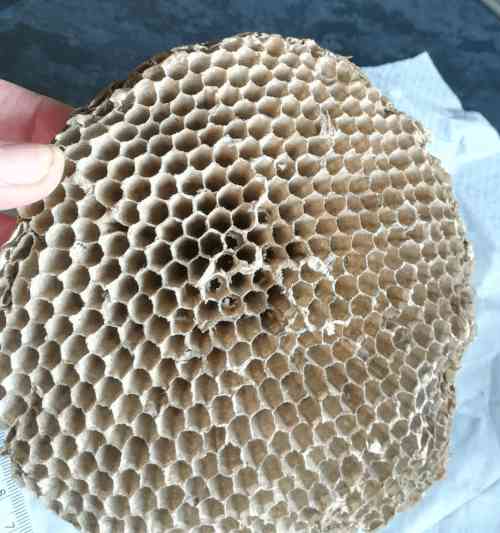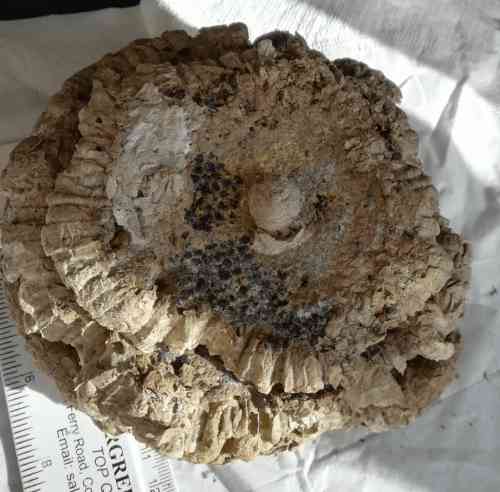The Structure Of A Social Wasp Nest
Wasps truly are wonderful and fascinating creatures. A social wasp nest is an incredible superorganism,
consisting of thousands of interdependent, industrious wasp individuals, all
serving the common good of the colony.
The nests they create are architectural masterpieces of hexagonal cells, painstakingly made from shavings of wood or leaf, and are, in my view, every bit as amazing in structure as the honeycombs created by honey bees (although of course, these nests don't contain honey, with the notable exception of the honey wasps).
What do wasp nests look like?
Fortunately, I have received many photographs of wasp nests over the years, which I am able to share with you now.
Some of these wasp nests were attached to buildings, such as a deck overhang, and provide a useful visual guide as to the outer appearance of a nest.
 A fully formed wasp nest on a deck overhang.
A fully formed wasp nest on a deck overhang.
However, I have also received a wonderful email from Deidre Shannon in Northern
Ireland, along with a range of superb photographs that enable us to get a view of the internal structure of a nest.
Out walking in the forest, she had come across remnants of a nest, scattered on the ground. Up above on a tree branch, there was a hanging ball – the rest of the remains of the wasp nest.
Below is a picture of a segment of the nest collected by Deidre. You can clearly see the extraordinary symmetry and preciseness of the hexagon-shaped cells.
 Deidre found segments of a wasp nest. Here is a segment of the nest showing the structure of the hexagonal nest cells.
Deidre found segments of a wasp nest. Here is a segment of the nest showing the structure of the hexagonal nest cells.Having gathered up the pieces of nest, Deidre took them home
to photograph in advance of donating them to a school nature table. I was thrilled to learn of this! I remember how, as a child, I had loved and felt inspired by our school nature table, and how I would
contribute to it on a regular basis all manner of things (horse chestnuts, leaves, feathers, pieces of bird egg shell and more).
Deidre sent her photographs to me along with questions
about the nest. I was of course pleased to answer, and I’m grateful to Deidre
for allowing me to share these pictures on my site.
Wasp nest in a tree
Below is a picture of the nest Deidre found in situ. The photograph is a little dark having been taken in the shadow of a tall tree, nevertheless, you can see that the nest is a kind of ball shape hanging from the tree branch.
 Wasp nest hanging from a tree branch.
Wasp nest hanging from a tree branch.
I can't be 100% sure (I don’t have any pictures of the
wasps), but it may be the nest of the Tree Wasp, Dolichovespula sylvestris, or possibly the nest of the Median wasp, Dolichovespula media.
 You can clearly see the extraordinary symmetry and preciseness of the hexagon cells.
You can clearly see the extraordinary symmetry and preciseness of the hexagon cells.
How is the wasp nest made?
In short, it’s made by the precise layering of tiny pieces
of chewed up wood. This process is
started by the queen wasp and continued by the workers.
All the 'architectural artwork' you are seeing is a result of the wasps sticking together the little pieces of chewed up wood, layered together to form hexagonal cells.
The hexagons are the cells where each individual wasp egg is laid, and develops until it emerges as a fully grown adult wasp.
Research on honeycombs suggests that hexagons guarantee the efficient use of materials and space within a nest. We can guess that this may be the reason wasps use them too.
 Layers of hexagonal cells are stuck together with spaces in between them. This space is almost like a 'gangway' or corridor, where wasps can move between the walls of hexagonal cells.
Layers of hexagonal cells are stuck together with spaces in between them. This space is almost like a 'gangway' or corridor, where wasps can move between the walls of hexagonal cells.
When the hexagonal cells are constructed, they are stuck
together a bit like plates with column supports, with a space in between. This space serves as a 'gangway' or
corridor, where wasps can move between the layers of hexagonal cells.
Around this structure is an outer covering that creates the ball type shape you see in the earlier picture.
Along with the queen, all of the worker wasps
have a part in building this masterpiece.

The social wasp life cycle and building of the nest
To expand further, it’s also worth putting the nest
building in to context with the life cycle of the fascinating wasp.
Wasp life cycles vary with species, but in the case of a number of social species such as those from the Dolichovespula genus, it starts with a queen, who emerges from her winter snooze (or diapause) in spring (having mated the previous year prior to hibernating).
The wasp queen gets to work gathering teeny
tiny shavings of wood that she chews to make a pulp, to make the first
few perfectly formed, hexagon-shaped cells.
In each of the cells, she lays an egg and seals up the cells. She continues with this process until the first eggs develop into larvae, pupate, then emerge as adults.
As soon as the young wasps are mature enough to leave the nest, off they go to forage for food for the remaining larvae back at the nest.
In addition to feeding the larvae, the worker wasps also
continue where the queen left off with nest construction, so they are now responsible for building the
rest of the nest, whilst the queen focuses on egg laying.
What
do wasps eat?
An interesting point here is that the worker wasps bring back other insects and insect larvae for the 'baby wasp' larvae to eat, but the adult wasp workers themselves don't eat the same thing.
Instead, the worker wasps actually feed from a sweet substance the wasp larvae secrete. So, workers feed wasp larvae, wasp larvae feed adult wasps.
(Later, as you'll see, worker wasps resort to finding sugar foods from elsewhere).
What next?
The wasp larvae back at the nest develop further: they spin
cocoons and pupate, eventually emerging as workers, and so it continues.
Later, the queen will stop laying eggs that will turn into
female worker wasps - she now switches to producing males and new queens.
By this time, the colony will be at around its peak, with thousands of worker wasps already out of the nest. At some point, there will no longer be any wasp larvae - or insufficient larvae to actually feed the adult wasps with their sugary secretions.
The end of the wasp colony
The photos taken by Deidre are from a colony coming to
the end of its life. At this stage, bits of hanging nest may begin to disintegrate
and fall off, revealing the wonderful intricate egg cell chambers inside.
Eventually, the whole colony will die apart from the new
queens - they feed, mate, then hibernate until the next year to ensure future generations of wasps.
Wasps are beneficial
Wasps really are beneficial. Not only are they pollinators, they also take crops pests that eat human foods. Many other species perform other vital roles in the ecosystem, such as helping control populations of pest cockroaches.
Personally, I think they deserve more recognition for their beneficial role.
Read more about wasp pollination.
Avoiding wasp stings
When a social wasp colony is at its peak, people may find wasps intimidating at this time,
especially if the wasps are interested in their fizzy drinks, but the key is
not to wave arms about.
They are defensive stingers, so if they feel threatened by your arm wafting, they are more likely to sting. Move calmly away, and the key is, don't drink fizzy drinks and eat fruit near wasps at this time of the year (peak colony time).
Early in
the year in spring, you'll find them less troublesome, but I think they deserve
a little more tolerance later in the year after all their hard work.
If you are concerned about wasps around your home, you could try hanging a Waspinator at the beginning of the season (early spring). They look a bit like wasp nests to queens looking for a place to build their own. Being territorial, the queen will avoid starting up a nest too close to other wasps.


